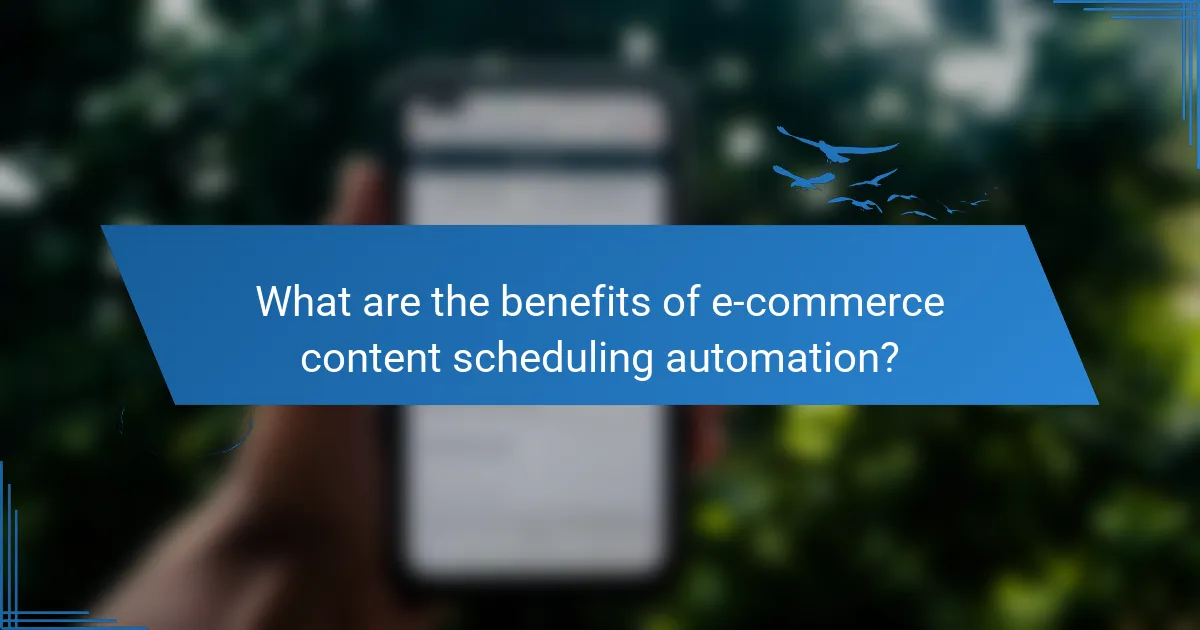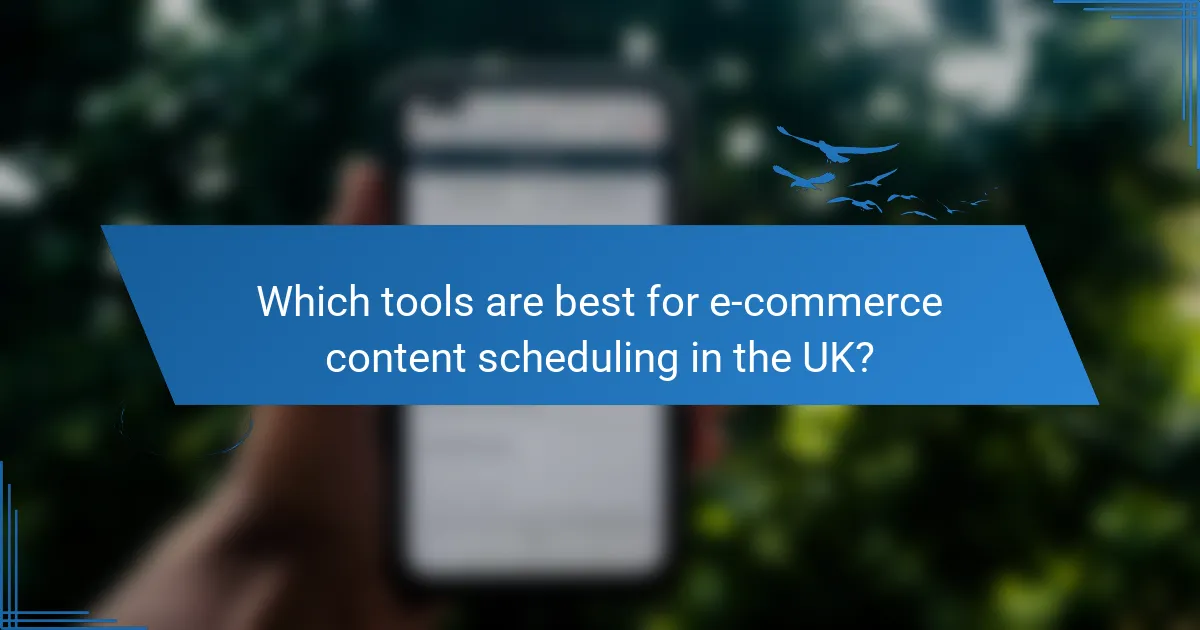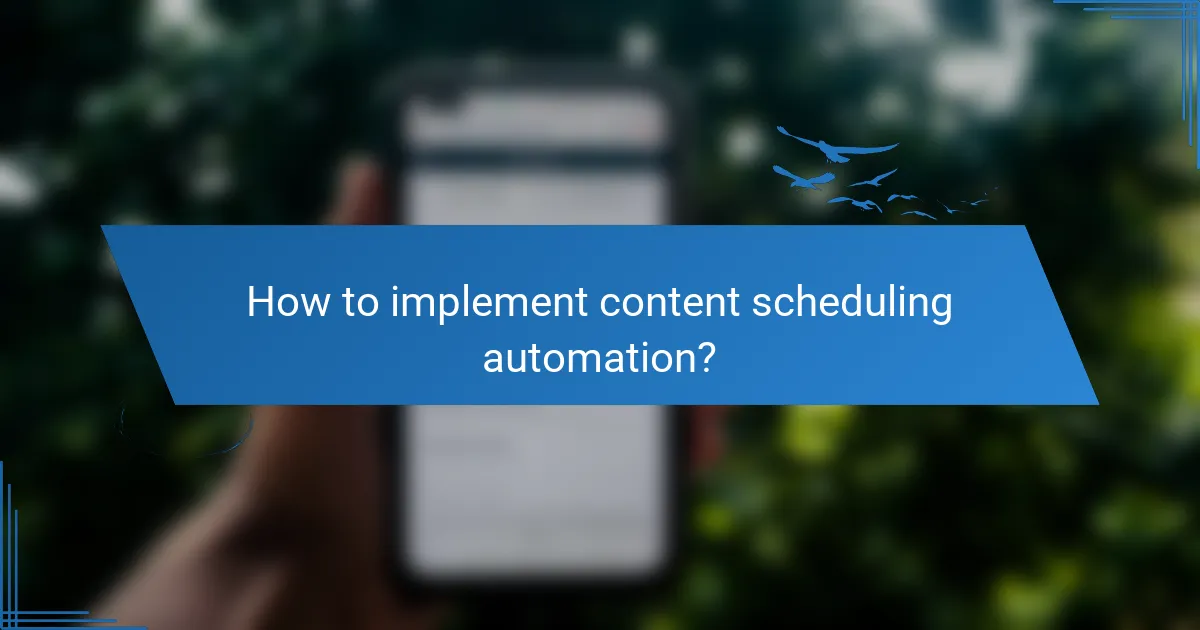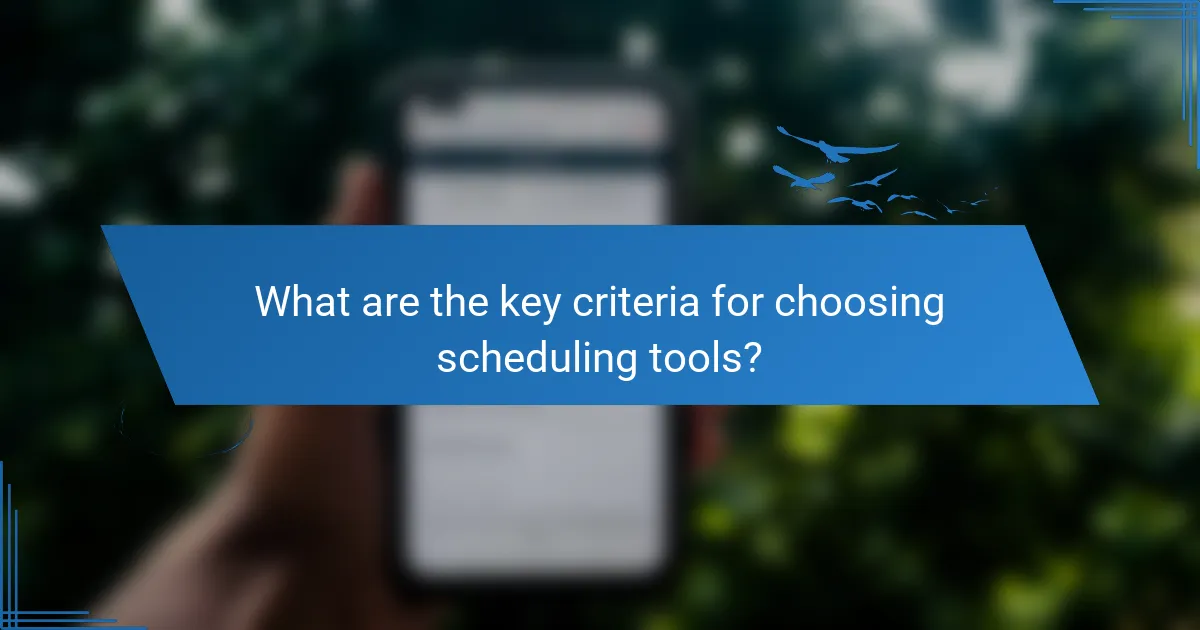E-commerce content scheduling automation provides businesses with the ability to save time, maintain consistency, and enhance audience engagement. By utilizing specialized tools, companies can streamline their operations and focus on strategic growth while ensuring that their content reaches the right audience at the right time.

What are the benefits of e-commerce content scheduling automation?
E-commerce content scheduling automation offers significant advantages, including time savings, improved consistency, and enhanced engagement with audiences. By automating the scheduling process, businesses can streamline their operations and focus on strategic growth.
Increased efficiency
Automation of content scheduling allows e-commerce businesses to save time by eliminating manual posting tasks. This efficiency enables teams to allocate resources to other critical areas, such as marketing strategy and customer service.
Using scheduling tools can help manage multiple platforms simultaneously, ensuring that content is distributed effectively across various channels. This capability reduces the risk of errors and missed opportunities.
Consistent publishing
Automated scheduling ensures that content is published consistently, which is crucial for maintaining audience interest and engagement. Regular posting helps build a reliable brand presence and keeps customers informed about new products and promotions.
By establishing a content calendar, businesses can plan their posts in advance, aligning them with marketing campaigns and seasonal trends. This foresight helps in maintaining a steady flow of relevant content.
Improved audience engagement
With automated content scheduling, e-commerce businesses can optimize posting times based on audience behavior and preferences. This strategic timing can lead to higher engagement rates, as content reaches users when they are most active.
Additionally, automation allows for the integration of interactive content, such as polls or quizzes, which can further enhance engagement. By analyzing audience interactions, businesses can refine their content strategies for better results.
Enhanced analytics
Automation tools often come with built-in analytics features that provide insights into content performance. By tracking metrics such as engagement rates, click-through rates, and conversion rates, businesses can make data-driven decisions to improve their content strategies.
Regularly reviewing these analytics helps identify successful content types and posting times, allowing for continuous optimization. This approach ensures that e-commerce businesses can adapt to changing audience preferences effectively.
Cost savings
Implementing automated content scheduling can lead to significant cost savings for e-commerce businesses. By reducing the need for manual labor in content posting, companies can lower operational costs and reallocate funds to other growth initiatives.
Furthermore, the efficiency gained from automation can lead to increased sales and revenue, thus offsetting initial investments in scheduling tools. Over time, these savings can contribute to a healthier bottom line.

Which tools are best for e-commerce content scheduling in the UK?
Several tools stand out for e-commerce content scheduling in the UK, each offering unique features to streamline the process. The best options include Buffer, Hootsuite, CoSchedule, and Later, which cater to various needs from social media management to comprehensive marketing strategies.
Buffer
Buffer is a user-friendly tool that allows e-commerce businesses to schedule posts across multiple social media platforms. It offers features like analytics to track engagement and performance, which helps refine content strategies over time.
With Buffer, users can create a posting schedule tailored to peak engagement times, ensuring that content reaches the audience effectively. The tool supports various formats, making it suitable for diverse content types, from images to videos.
Hootsuite
Hootsuite is a robust platform designed for managing multiple social media accounts in one place. It provides advanced scheduling options, allowing e-commerce brands to plan campaigns well in advance and monitor their effectiveness through detailed analytics.
This tool is particularly beneficial for larger teams, as it supports collaboration and offers features like content curation and social listening. Hootsuite’s flexibility makes it ideal for brands looking to maintain a consistent online presence.
CoSchedule
CoSchedule is a comprehensive marketing calendar that integrates content scheduling with project management. It is particularly useful for e-commerce businesses that want to align their marketing efforts across various channels.
The tool allows users to visualize their content strategy and adjust timelines easily. CoSchedule also offers automation features that can save time, making it easier to focus on content quality and engagement.
Later
Later specializes in visual content scheduling, making it a great choice for e-commerce brands that rely heavily on imagery, such as fashion or home goods. It allows users to plan and preview their Instagram feed, ensuring a cohesive aesthetic.
With features like linkin.bio, Later helps drive traffic directly to product pages, enhancing the shopping experience. This tool is particularly effective for brands looking to maximize their visual storytelling and engagement on social media platforms.

How to implement content scheduling automation?
Implementing content scheduling automation involves defining your content strategy, selecting the right tools, setting up a content calendar, and automating the posting process. This approach streamlines your workflow and ensures consistent content delivery across platforms.
Define content strategy
A clear content strategy outlines your goals, target audience, and the types of content you plan to produce. Consider what messages resonate with your audience and how often you want to engage them. This foundational step guides all subsequent actions in your automation process.
Identify key themes and topics that align with your brand and audience interests. For example, if you run an online clothing store, focus on seasonal trends, styling tips, and promotions. This targeted approach enhances engagement and drives traffic.
Select appropriate tools
Choosing the right tools is crucial for effective content scheduling automation. Look for platforms that integrate well with your existing systems and offer features like analytics, social media management, and user-friendly interfaces. Popular options include Hootsuite, Buffer, and Sprout Social.
Evaluate tools based on your specific needs, such as budget constraints and the number of platforms you manage. Some tools offer free tiers, while others may charge monthly fees ranging from low tens to hundreds of USD depending on features and user capacity.
Set up a content calendar
A content calendar helps you plan and visualize your content schedule over weeks or months. Start by mapping out key dates, such as holidays or product launches, and fill in your planned posts accordingly. This organization prevents last-minute scrambles and ensures a steady flow of content.
Consider using templates or digital tools like Google Calendar or Trello to manage your calendar. Regularly review and adjust your calendar based on performance metrics and audience feedback to optimize your content strategy.
Automate posting
Once your content is planned and scheduled, use automation tools to post content at optimal times without manual intervention. Most scheduling tools allow you to set specific dates and times for each post, ensuring consistent visibility across platforms.
Be mindful of platform-specific guidelines and peak engagement times. For instance, posting on social media during evenings or weekends may yield better results. Regularly monitor the performance of your automated posts to refine your strategy and improve engagement rates.

What are the key criteria for choosing scheduling tools?
When selecting scheduling tools for e-commerce content, focus on user interface, integration capabilities, and pricing models. These criteria ensure that the tool meets your operational needs, fits seamlessly into your existing systems, and aligns with your budget.
User interface
A user-friendly interface is crucial for efficient scheduling. Look for tools that offer intuitive navigation, clear layouts, and easy access to features. A well-designed interface minimizes training time and enhances productivity.
Consider tools that provide customizable dashboards and drag-and-drop functionality. This allows you to quickly adjust your content calendar and respond to changes without hassle.
Integration capabilities
Integration capabilities determine how well a scheduling tool works with your existing e-commerce platforms and marketing software. Choose tools that can easily connect with popular systems like Shopify, WooCommerce, or email marketing services.
Check for APIs and pre-built integrations that facilitate data sharing. This ensures that your scheduling tool can pull in product information and analytics, streamlining your content management process.
Pricing models
Pricing models vary widely among scheduling tools, so it’s essential to evaluate what fits your budget. Some tools offer subscription-based pricing, while others may charge per user or based on the number of scheduled posts.
Look for transparent pricing structures and consider any additional costs for premium features. Free trials can also help you assess the tool’s value before committing to a plan.
